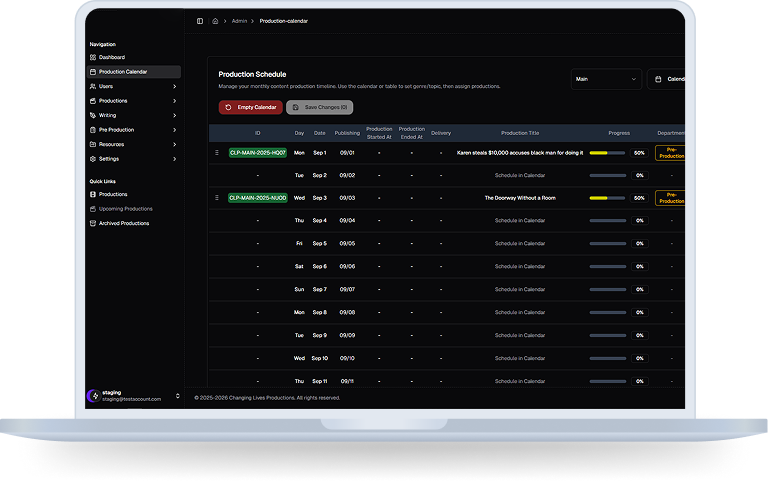Client Overview
Changing Lives Production (CLP) is a California-based media and film production company with a team of 200+ creatives working across 8 active studios. Storytelling is in their DNA – fast-paced, emotional and powerful. On average, they roll out 5-6 short films every week, and with their growing momentum, they’re now scaling up to reach 8-10.
Beyond the studio floor, CLP has built a strong presence on YouTube, TikTok, and Instagram, where their short-form content reaches and engages a wide audience. This digital footprint keeps their films in constant circulation, helping them stay relevant in a space where attention spans are short and competition is high.
As Dhar Mann himself shared in his CNBC interview, building a strong business model and streamlining operations has been key to scaling CLP. The introduction of automation is simply the next chapter in that journey, designed to help the team create more impact with less manual effort.
The Production Bottleneck
At first glance, CLP looked like a well-oiled production house—8 studios, 200+ team members, and millions of fans waiting for their next film. But behind the camera, the daily workflow told a different story.
Like many ambitious production houses, CLP started to hit the usual roadblocks—manual processes, endless spreadsheets, and scattered communication across departments like pre-production, writing, shooting, and post, Social. What should have been seamless coordination often turned into time-consuming back-and-forths, slowing down the team’s creative flow.
Scripts took too long to prepare
Every script had to be manually annotated – highlighting scenes, tagging props, assigning characters. This process alone took hours, eating into creative time. Imagine three hours of work just to prep one script, multiplied across 5-6 films a week.

Task Assignment Chaos
Once scripts were broken down, teams at different stages like props, wardrobe, makeup etc. had to manually create tasks in Monday.com. Updates were rarely in sync, meaning nobody had a single source of truth.
Manually task creation inside Monday.com
Although CLP was using Monday.com, the team still had to manually create and update every task in the system. For each film, this meant hundreds of line items being typed manually, a time-consuming process that often led to errors, missed updates, and frustration among the production crew. Instead of Monday.com saving time, it was turning into yet another manual burden.
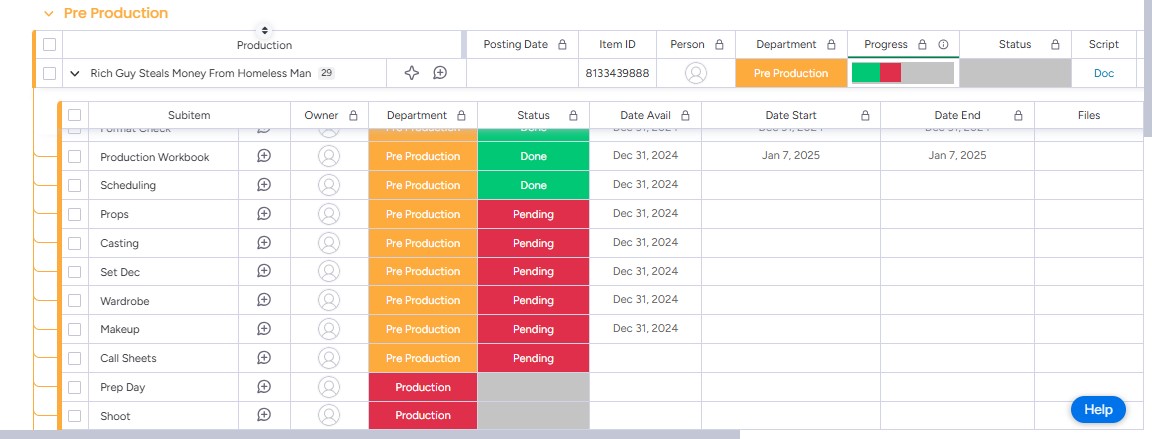
Scheduling was a Nightmare
With multiple actors, sets and locations, scheduling school was like solving a giant jigsaw puzzle – manually. Every update meant rewriting call sheets, often late into the night.

Department Communication Gaps
Notes between teams (e.g., Props → Makeup about costume changes) were passed via scattered sheets or email chains. Many slipped through the cracks, leading to last-minute surprises on set.

Founder Pulled Into Micro-Management
Instead of focusing on strategy and creative leadership, the founder had to constantly check in with departments, verify updates, and resolve coordination issues. This level of micro-management from the top was unsustainable and drained leadership energy.
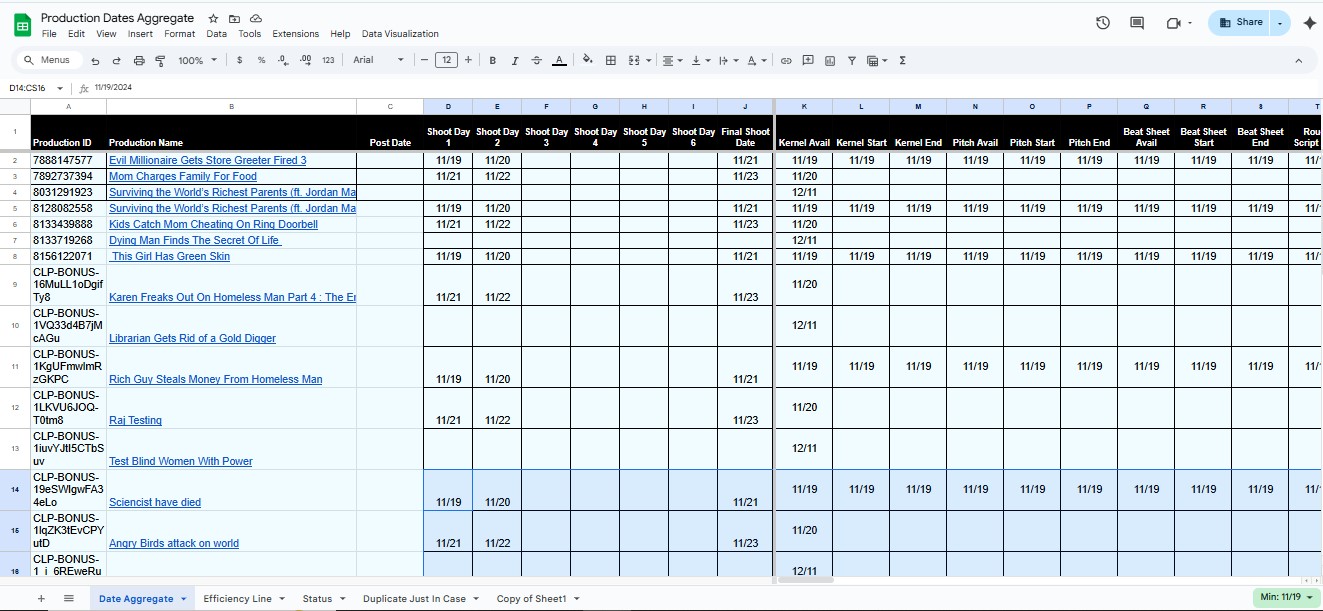
Previous automation attempts had failed
CLP had already worked with another vendor to try and automate parts of their workflow. Unfortunately, the solution delivered was fragmented and unreliable. Instead of solving the problem, it added new layers of complexity, leaving the team frustrated and hesitant, but still in need of a better system.
No centralized way to find productions or track progress
With so many films in motion, team members often struggled to locate which stage a production was at. Was it still in writing? Was shooting complete? Without a master tracker, productions felt scattered, and teams wasted time just trying to figure out the status.
Missing crew templates for shoots
On the workbook side, there weren’t proper templates for assigning and briefing crew members. This meant every shoot required custom setups, and details for crew responsibilities were often unclear or repeated from scratch each time.
Casting and actor booking lacked structure
The casting process was another pain point. There wasn’t a properly designed system for booking actors, storing their details, or linking them to specific roles. This created delays in finalizing casts and caused confusion between casting directors and production leads.
“We had the talent, the stories, and the team – but we lacked systems. We needed something to hold it all together.”
– Ruben, Head of Production
🎯 What they needed :
Centralized, intelligent, and scalable workflow automation.
That’s where we stepped in. CLP partnered with us to bring automation into their workflow, using smart tools and Google-powered solutions to save time, give everyone clearer visibility, and reduce the daily micro-management that was weighing the team down.
Script Annotation & Extraction Engine
We started by tackling the scripts themselves. The team needed a faster way to break down stories into actionable data. So, we built a custom Google Workspace Add-on that allowed them to highlight different elements right inside their script:
- Scenes in blue
- Characters in green
- Props in yellow
Once tagged, the add-on extracted everything into a structured Google Sheet—complete with scene lengths, character roles, and prop lists. What used to take hours now happens in minutes.

Scene Breakdown + AI Summaries
Highlighting was only the first step. Next, scripts ran through a multi-step extractor:
- Scene lengths were calculated automatically (based on text size/pixel height).
- Gemini AI generated quick scene summaries, saving teams from reading pages of script just to get the gist.
- All extracted data was neatly organized into department-ready spreadsheets.
This gave every team member, from casting to wardrobe, a clear, ready-to-use view of what was coming up.
Smart Scheduling System
Scheduling had always been one of CLP’s biggest headaches. We solved it by feeding script metadata like actor IDs, location tags (INT/EXT), and set codes (DM1, DM2) into a smart scheduling engine.
From there, the system:
- Generated rough schedules for upcoming shoots
- Built context-specific schedules (e.g., grouped by filming location)
- Synced everything back to a ‘centralized sheet’
For the first time, scheduling didn’t feel like guesswork, it was structured and reliable.
Custom Casting Web App (Built in NextJS)
Casting is a delicate balance of creativity and logistics. To make it smoother, we built a drag-and-drop casting app:
- Directors could assign roles effortlessly through a card-based drag-and-drop system
- Ratings and feedback were collected in real time
- Top-rated actors appeared automatically for certain roles
- Finalized assignments synced directly into the casting sheet
This gave casting directors a tool that felt simple, yet professional.
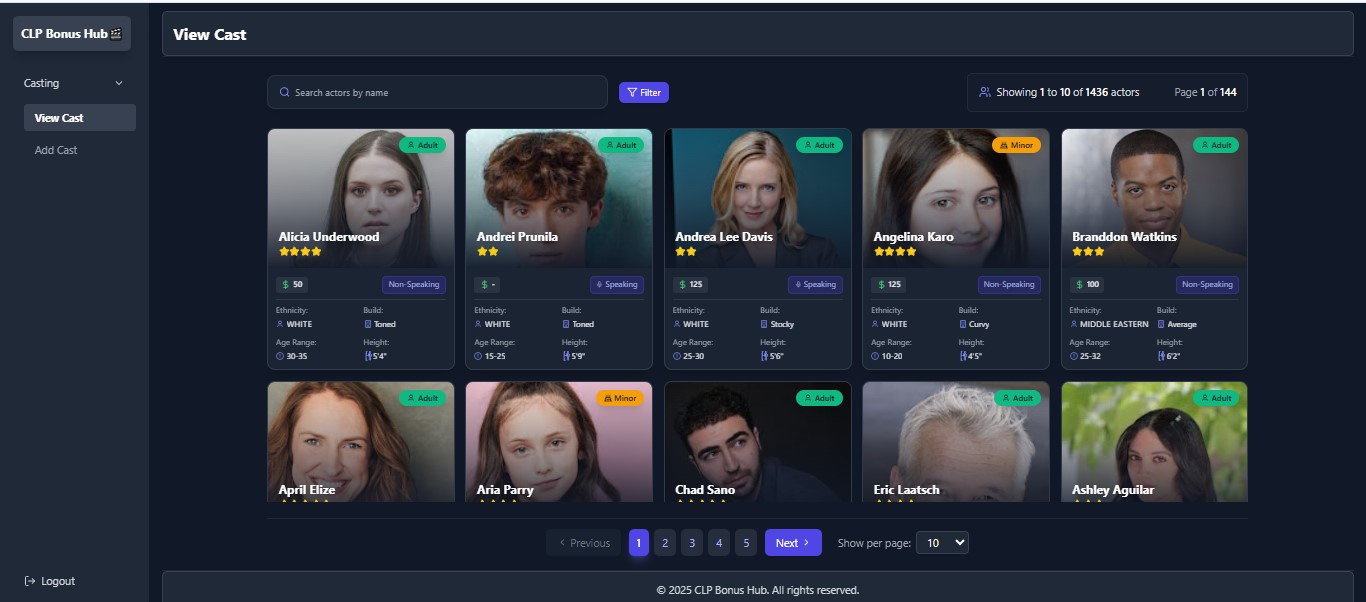
Internal Notes Manager
Cross-department chatter often got lost in emails or side conversations. We fixed this with a Notes Manager Add-on:
- Departments could pass notes (e.g., Props → Makeup about a costume detail)
- All notes collected in a “Master Notes” sheet with color-coded statuses (Green = Done, Yellow = In Progress, Red = Blocked)
- Everyone could see the same version, in real time
It was like giving each department a shared bulletin board that actually worked.
Slack Integration for Real-Time Alerts
To keep teams in sync without constant email chains, we connected the system directly to Slack. Key updates like a script status change, a new casting assignment, or a call sheet ready for review, were instantly pushed into dedicated Slack channels.
Instead of waiting for someone to check a sheet, departments got real-time pings where they were already working. That meant fewer missed updates and faster responses on time-sensitive tasks.
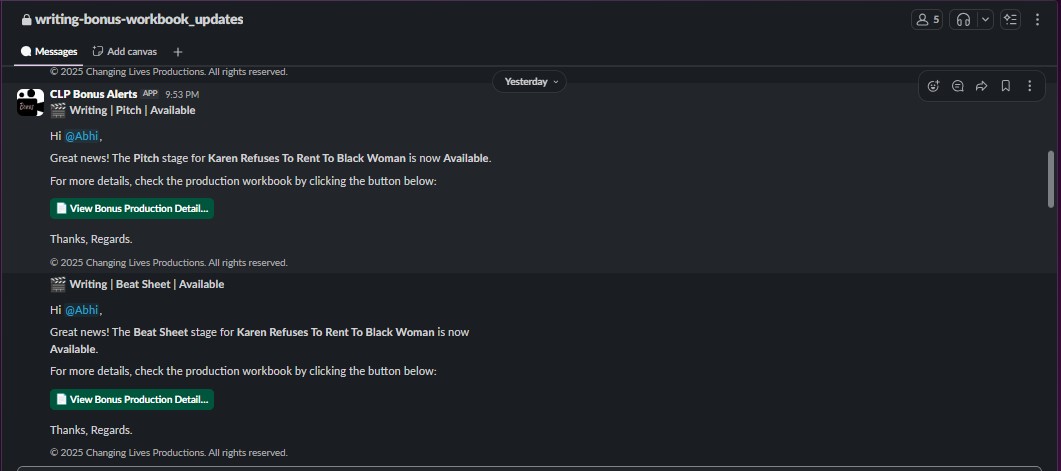
Automated Call Sheets with Weather Forecas
Finally, we made call sheets smarter. Using a Weather API, call sheets were auto-generated with daily scene details, actor data, and real-time weather forecasts for the shoot location. Each sheet was versioned (Prep Day, Shooting Day, etc.), so no one had to worry about missing the latest update.
No more surprises with sudden rain or last-minute confusion about which version was correct.

User Management Module
The User Module let admins create and assign roles like User, Admin, or Supervisor with specific access rights. This ensured secure, role-based control over platform features and maintained accountability.
Solutions Provided
Our approach wasn’t to throw another
complicated system at CLP. Instead, we broke
their challenges into modular, scalable solutions,
each designed to connect seamlessly into the
bigger workflow. Using Google Apps Script, Google
Workspace tools,and smart integrations, we
transformed what used to be a creative mess into
a synchronized, automated machine.
Production Dashboard: One View To Rule Them All
We developed a live, filterable dashboard using
“Production Dates Aggregate”
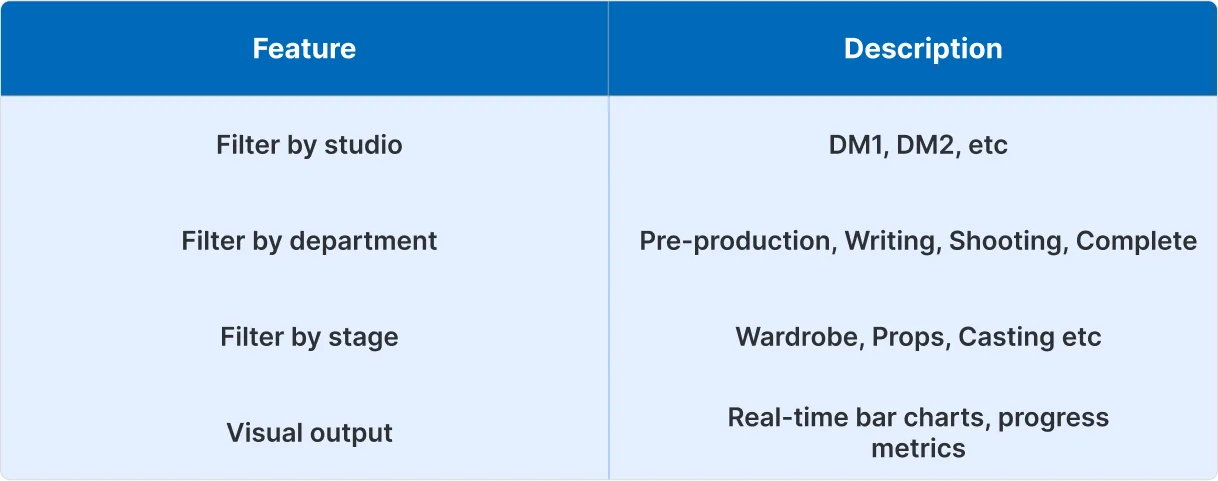
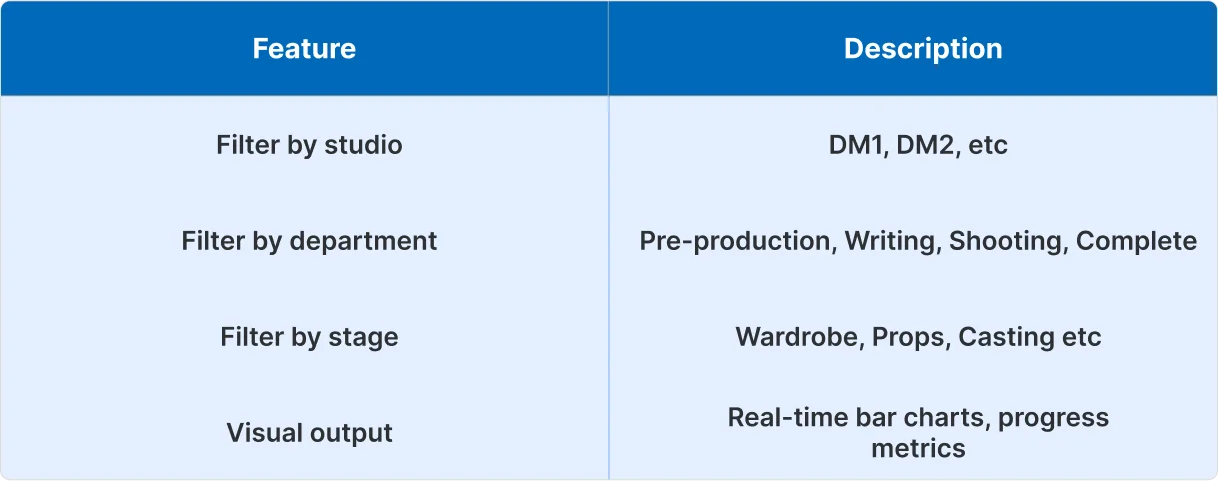
Technology Stack
Automation
Google Sheets, Google Docs, Notify to Department via Google Email, Slack, Generate Auto Report When All Stages Are Done
UI Add-ons
Google Workspace Add-on SDK
Web App
ReactJS (Casting Tool)
Integrations
Slack, Weather API
AI Layer
Gemini AI
Dev Pipeline
CLASP (local development & deployment for GAS)
Measurable Impact
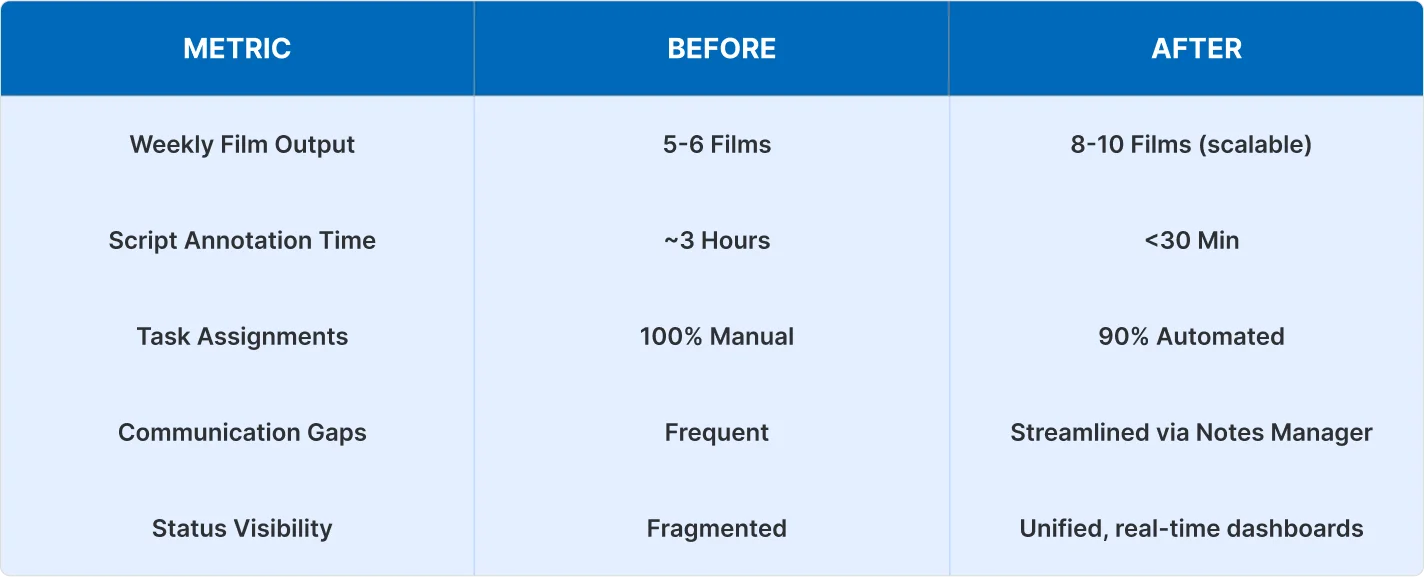
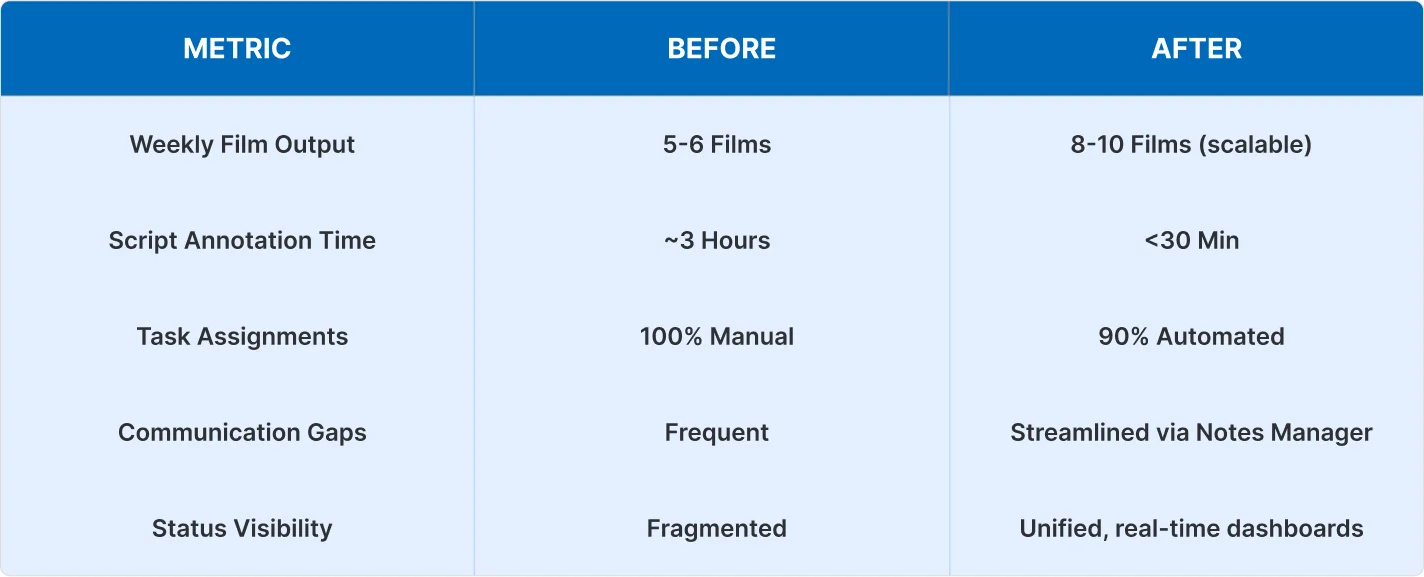
Client Feedback
This system has changed everything. From the script screen,
we now move faster, cleaner and without the chaos. The
entire is more focused on creativity than coordination.
-Ruben, Head of Production, CLP
WHAT’S NEXT?
CLP is now preparing to expand this system into a full-fledged production
SaaS platform. Upcoming developments include:
SaaS platform. Upcoming developments include:
A responsive mobile interference for on-site crews
Budget & effort prediction using AI
Full MVP Web App modeled after Studiobiner + Studiovity
Download The Case Study
You’re one step away from building great software. This case study will help you learn more about how BMV System Integration helps successful companies extend their tech teams.

